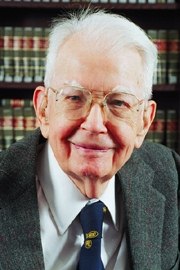Coase illustrates this principle with an example involving a farmer and a rancher who occupy adjacent parcels. The rancher’s cattle sometimes stray onto the farmer’s land and damage his crops. Coase’s claim is that it doesn’t matter whether the law holds the rancher liable for the damage to the farmer’s crops or not: either way, the rancher and farmer will reach a bargain that maximizes the joint value of the rancher and farmer’s output.
The argument (which is worth reading in its entirety) proceeds as follows. If the law requires the rancher to pay the farmer compensation, then the rancher will only expand his herd if the increased profits from doing so exceed the compensation he will be forced to pay the farmer as a result. Conversely, if the law does not require the rancher to compensate the farmer, then if the farmer’s crops are worth more than the rancher’s cattle, the farmer will pay the rancher not to expand the size of his herd. Coase’s theorem says that the size of the herd—and hence, the total value of the goods produced by the farmer and rancher combined—will be the same under either legal regime, and that the amount produced will maximize social welfare.
 In subsequent writing, Coase has emphasized that his point was not that this was a realistic model for how the world actually worked, but rather that economists need to take more seriously the importance of transaction costs in economic analysis. Many free-market scholars in the law-and-economics tradition employ Coase’s argument in making their case for reducing transaction costs and thereby increasing market efficiency.
In subsequent writing, Coase has emphasized that his point was not that this was a realistic model for how the world actually worked, but rather that economists need to take more seriously the importance of transaction costs in economic analysis. Many free-market scholars in the law-and-economics tradition employ Coase’s argument in making their case for reducing transaction costs and thereby increasing market efficiency.
A version of this argument pops up pretty frequently in discussions of patent policy. We saw some examples in last week’s comments regarding my criticism of Intellectual Ventures. Robb Shecter, for example, argued that firms like IV are valuable because they “introduce liquidity into the system.” While Robb didn’t explicitly reference Coase, the key assumption seems to be that greater liquidity gets us closer to that zero-transaction-cost world in which patents are allocated to their highest-value use. F. Scott Kieff, writing for the Cato Institute, offered a similar criticism of the Supreme Court’s LG v. Quanta decision. By placing limits on patent holders’ ability to sub-divide patent rights, Kiff warned that the court would “frustrate patent deals by taking contracting options off the table.”
This approach to patent policy strikes me as misguided. The fundamental problem is that it forgets that a patent is not a productive asset like a truck or a factory. A liquid truck market is a good thing because the highest-valued use of a truck will likely be the use that gets the most valuable cargo to consumers. In contrast, a patent by itself produces nothing of value. It is not an input to any productive process. It simply entitles its holder to sue those who enter a particular market. There is, therefore, no a priori reason to think that a more liquid market for patents will enhance social welfare. To the contrary, patents are valuable precisely because they allow firms to increase their profits by doing things that economists generally regard as economically damaging: litigate and limit competition.
Indeed, in some industries, high transaction costs are probably the only thing preventing patents from bringing business grinding to a halt. In the software industry, for example, there is a large number of broad, vague patents that are routinely infringed by numerous software firms. The only reason we still have a relatively healthy software industry is that it’s more work than it’s worth to find and sue all the people who are infringing—which, to a first approximation, is everyone. This is not a process we want to make more efficient.
 And this is where IV comes in. IV’s business model is to amass such an imposing packet thicket that, simply as a statistical matter, it’s probable that any given technology company infringes a large number of its patents. Once IV has a suitably imposing patent thicket, it benefits from a twisted kind of economy of scale. It no longer has to bother with cataloging the patents any given company infringes; it’s enough to identify a few representative examples and then gesture in the general direction of its menacing 27,000-patent portfolio. This will induce most companies to pay up without a fight, leaving IV with plenty of resources to make examples of the few that resist.
And this is where IV comes in. IV’s business model is to amass such an imposing packet thicket that, simply as a statistical matter, it’s probable that any given technology company infringes a large number of its patents. Once IV has a suitably imposing patent thicket, it benefits from a twisted kind of economy of scale. It no longer has to bother with cataloging the patents any given company infringes; it’s enough to identify a few representative examples and then gesture in the general direction of its menacing 27,000-patent portfolio. This will induce most companies to pay up without a fight, leaving IV with plenty of resources to make examples of the few that resist.
This “reduces transaction costs” in a sense, but it’s a mistake to assume this makes it socially beneficial. Coase’s theorem is fundamentally about two productive parties negotiating toward an arrangement that maximizes their joint product. It’s not about a situation in which one firm is in the business of producing wealth and the other is in the business of using the threat of lawsuits to extract it from the first party. When the patent system is as dysfunctional as ours is, the limited liquidity of the patent market is a crucial check on the amount of damage these firms can do. The patent system’s flaws aren’t Nathan Myhrvold’s fault, but firms like his greatly magnify the damage they can cause.




I have to agree with you. There are often serious external costs to having low transaction costs. Consider the Byzantine Generals problem which flows from the low transaction cost of betrayal at the imperial level. Can you imagine the 19th century if someone had the sense and ability to patent every possible gearing ratio and then imposed a tax on just about any new piece of machinery? How different is it to patent genes or just genetic sequences? Why not take out patents on various networks of user interface, network and interaction components?